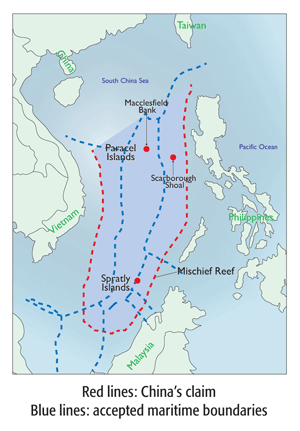
China has extended its reach over the Spratly Islands, which lie in the South China Sea. Its muscle-flexing has rattled its neighbours – and the US. Simon Wilson and Hector Reid report.
What’s happened?
China announced this week that it will “soon” complete its mammoth land reclamation work in the Spratly Islands, a barely populated archipelago in the southern part of the South China Sea. The area is at the centre of a web of competing territorial claims – and the focus of growing regional and global tensions over China’s long-term plans.
The disputed islands (known as the Nansha Islands in Chinese) lie amid some of the world’s busiest shipping lanes ($5trn worth of ship-borne trade passes through the South China Sea each year), rich fishing grounds and potential undersea reserves of oil, gas and minerals. Neighbouring countries and America fear that China aims to use the islands as military bases and assert control over navigation rights in the South China Sea.
Whose territory do the islands lie in?
They lie in international waters, but in recent years China has been increasingly assertive that it should have sole sovereignty over almost the entire South China Sea. Chinese maps – and now even its passports – show a “nine-dash-line” heading south from Taiwan and skirting the coasts of the Philippines, Malaysia and Vietnam, purporting to map the limits of Chinese control, supposedly based on ancient rights. However, several countries, not just China, have been busy reclaiming land in an attempt to bolster their territorial claims.
So what’s different about China’s building?
Its scale, its speed, and the fact that it comes on the back of years of similar moves. According to US defence secretary Ash Carter, China has now filled in more than 2,000 acres (810 hectares) – more than all the other claimants combined – in the past 18 months. The official line from China is that the construction programmes are “not targeted at any other country, do not affect the freedom of navigation and overflight enjoyed by all countries in the South China Sea” and are therefore “beyond reproach”. America and others aren’t convinced – not least because just weeks ago a US Navy plane with a CNN film crew was repeatedly challenged by Chinese forces and told to leave the area.
Does this matter?
Yes, if it is a sign of things to come from China. By asserting its sovereignty over the Spratly Islands, Beijing is essentially claiming dominion over the entire South China Sea. Under the 1982 UN Convention on the Law of the Sea, coastal states have a lawful claim to “economic exclusion zones” extending 200 nautical miles from their shorelines. If China had sovereignty over the Spratly Islands, it would extend its zone, so up to five neighbouring countries would be limited to fishing and exploring for resources in narrow bands of sea along their coastlines.
Roughly 40% of the world’s trade passes through this region, and costs could rise significantly if domestic Chinese laws – rather than international ones – applied to marine traffic. Finally, there is the question of where this power projection will end. Some fear China could ultimately extend its reach and face off against its long-time rival, and American ally, Japan.
What has China got to say?
It has repeatedly stated that its sovereignty is “indisputable”, and that it is in its interests to foster peace and stability in the South China Sea. It points out that military exercises between the US Navy and the Asean group of ten southeast Asian countries have proliferated in recent years. A popular view among the Chinese public is that China has been “forced” to reclaim the Spratly Islands to ensure its national security, as America builds military cooperation with the Philippines and strengthens its naval partnership with Japan.
What does this mean for other countries in the region?
Few countries in the region seem comfortable with China’s muscle flexing, but Vietnam, which had a run-in with China last year, and the Philippines are especially rattled. But both countries can probably rely on American support in a bind. President Obama recently said that “just because the Philippines or Vietnam are not as large as China, doesn’t mean that they can just be elbowed aside”.
So what’s the solution?
It’s hard to tell. US defence secretary Ash Carter has called for “an immediate and lasting halt” to China’s building programme, but has also noted that “there’s no military solution to the South China Sea disputes”. China won’t back down easily. “The determination of the Chinese side to safeguard our own sovereignty and territorial integrity is as firm as a rock,” said foreign minister Wang Yi. “And it is unshakable.”
Is China preparing military action?
It’s no secret that China is beefing up its military capacity. Beijing’s defence spending will rise by 10.1% this year, the 27th year in a row of double-digit or near double-digit increases. China is now the world’s third-largest arms dealer, with arms exports increasing by 143% in the last five years, according to a study by the Stockholm International Peace Research Institute.
But is China really preparing to use its military? Russia increased defence spending in the build up to its annexation of Crimea in 2014, but there is no indication that China is preparing something similar. For the moment at least, it appears to be focusing on projecting power in its own strategic backyard and keeping American influence at bay.